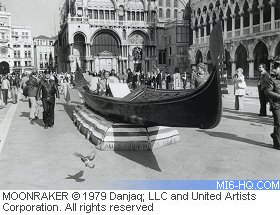 |
| |
In December 1978, the press were on hand to cover the filming of Moonraker in Venice amongst the tourists, student protests and suspected terrorists...
|
|
That Sinking Feeling In Venice
19th April 2011
"Venice proves to be difficult for cast, crew of Moonraker" - December 1st, 1978 (NEA)
The city of Venice has been around for a thousand years, give or take a century, and an ancient St Mark's Square has seen everything - from Marco Polo to tourists from Texas. But the place may never recover from the sight of James Bond in a motorized gondola fleeing across the Square, scattering the famed pigeons and the sidewalk cafe denizens, as he once more shows his elegant heels to the villains.
This is a scene from the latest Bond movie, "Moonraker," which is being shot on location all over the world. Already, scenes have been filmed in London and Paris and, later, the company will go to Rio de Janeiro and South America's most thrilling spot, Iguacu Falls.
Now they are in Venice, for a three-and-a-half week shooting session that will cost more than $1 million and result in possible 10 minutes on the screen. The Bond movies, like everything else, keep getting more and more expensive. This one, says producer Albert R. (Cubby) Broccoli, will be in the $25 million area.
When the first came to Venice, the rains came, too. And Venice, a city that is under water even on dry days, is impossible when it rains. The water in St. Mark's Square was mid-calf deep. Fortunately, the weather has changed, and the warm Adriatic sun has returned.
Roger and Luisa Moore sit at the end of the Square. Luisa, who is Italian, calls him "Reogerino." They are both suave, sophisticated people. They have homes in Paris, Italy and Switzerland. "I was the last one to live in England," Moore says. "I stayed to put out the lights. It is impossible for actors there now - my tax bracket was 83 percent, which is ridiculous."
They like Italy, but working in Venice is another matter. It is difficult. They feel trapped, Moore explains. The thousands of tourists, roaming the relatively small expanse that is Venice, have nothing much to do. So when they see a movie company and, particularly, this movie company, they throng in.
Italy, today, is jittery about terrorism. The movie company has been exceptionally security conscious. And, as they prepared for the scene of the gondola zipping across St. Mark's Square, there were even more so.
One of the assistant directors looked at the crowd nervously. Then he went over to where Broccoli, executive producer Michael Wilson and director Lewis Gilbert were conferring. He said he suddenly noticed many young men in the crowd wearing armbands. He was right. Here and there, among the crowd of camera-carrying tourists, there were red armbands. |
|

|
The film's executives alerted their security forces. "I think we're in for trouble," Wilson muttered. A Venetian laughed. These red arm bands, happily, were innocent. They belonged to members of a group called Servizio d'Ordine, a kind of auxiliary ice force.
There had been some trouble the day before. A group of students had suddenly appeared and stood firmly in front of the camera. They refused to budge. They said they should either be in the film or get paid to stay put. "We were advised not to pay them," Broccoli said, "lest we started something that we couldn't stop." He said, vaguely, that they made "and arrangement" with the students, who left peacefully.
Another day the producers and director held a discussion about where they should shoot next. The Italians, passing by carrying loaves of bread and pushing handcarts, stopped and entered into the discussion. Soon there were a dozen people, talking in English and Italian, gesticulating wildly, arguing about where to shoot next.
This was such a typical scene - the Italians and the tourists crowding around and interfering with the shooting - that eventually the company established a technique of diversionary tactics. They had one group of people with a high profile, ostensibly doing important filming. That attracted the crowds, while the real filming went on quietly in another location.
The scene around the company is very international. Instructions are given in Italian, French, English and Spanish. The crew's leading character is a grip named Wellington who is an English gypsy with a bulldog tattooed on his arm and a Barry Manilow T-shirt. The still photographer is a Frenchman with an Irish name who is reputed to be a stepson of a former U.S. ambassador to France.
While the diversionary tactics keep the crowd on St. Mark's Square, at the water's edge they are shooting the critical scene of the gondola emerging from the water. This is one of the big Bondian gimmicks in "Moonraker." As Bond flees the bad guys, he pushes a button in the gondola and it turns into a hovercraft. The transformation is aided by cables and motors and four or five frogmen, in the canal, pushing the gondola up and out at the critical moment.
"No wonder I have ulcers," says Broccoli, watching frogmen heave and the cables stretch. "Suppose one of these cables snaps? We could have a lot of injuries." But the cable remains intact, and the gondola zips neatly out of the water and begins to move across the square. And an old gondolier sees it and silently crosses himself.